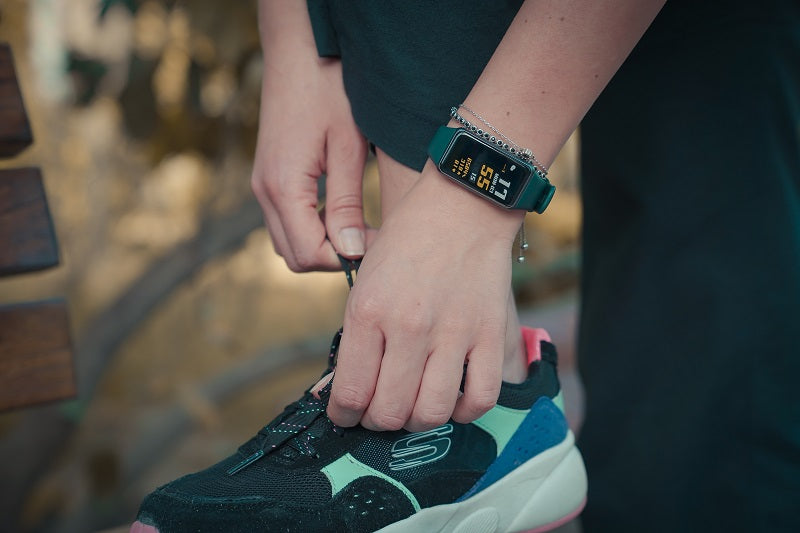Why Wrist-Based Heart Rate Monitors Are All The Rage

It used to be that heart rate monitors were reserved for serious athletes and those with heart conditions. But now, with the rise of wrist-based heart rate monitors, everyone from casual exerciser to fitness fanatic is tracking their heart rate. In this blog, we’ll explore why wrist-based HRMs have become so popular, the benefits of having access to all this data and take a look at the pros and cons of using them for training. Finally, we’ll share some tips and tricks on how to get the most out of your wrist-based heart rate monitor
Shop our award-winning sports nutrition
Why are wrist-based HRMs so popular?
Wrist-based HRMs have become popular for several reasons, including:
Convenience and comfort - one of the primary reasons people are drawn to wrist-based heart rate monitors is their convenience and comfort. Unlike chest straps, which can be uncomfortable and cumbersome (not to mention a pain to wash and dry between sessions!), wrist-based monitors sit snugly on your wrist and are easy to wear throughout the day without interfering with your daily activities.
Accuracy - though they've taken a couple of years to match the traditional chest-based monitors, wrist-based HRMs have now become incredibly accurate. Thanks to advanced optical sensors, these monitors work even during high-intensity workouts. The latest versions even track heart rate variability (HRV), providing a more comprehensive picture of your heart health.
Data analysis - most come equipped with software that provides valuable fitness insights. The data can be synced with your smartphone, fitness tracker or training platform, making it easy to view and analyze your progress. You can track factors like calories burned, steps taken and monitor your sleep quality.

A lot of data can be stored and analysed on a wrist-based HRM
Versatility - wrist-based heart rate monitors are versatile gadgets that can be worn during a variety of activities as well as during everyday activities like walking or yoga.
Motivation - finally, wrist-based heart rate monitors can be incredibly motivating. They provide real-time feedback on your heart rate, allowing you to make adjustments to your training intensity or make changes to your training plan.
Downsides of wrist-based heart rate monitors
While wrist-based HRMs are convenient and easy to use, they do have some downsides. One of the biggest downsides is that they can lose their accuracy specifically during high intensity interval training. This is the one area my wrist-based HRM let's me down: during 30-second spints on the track or treadmill. I think the delay in HR response and the sharp, sudden movements just confuses the watch too much. Additionally, wrist-based HRMs can sometimes be uncomfortable or not fit properly, leading to inaccurate readings.
Wrist-based heart rate monitors for training: Pros vs Cons
Let's take a look at the pros and cons of using wrist-based HRMs during training over the traditional chest-based monitors.

First up, the pros:
- Easy to use – Wrist-based heart rate monitors are incredibly easy to use. Wear it like any old watch and get real-time data about your heart rate. Most models come with an accompanying mobile app to which you can download data and get further insights. It's much easier to track progress here or identify when you might need to adjust your training.
- Convenient – Another significant advantage of wrist-based heart rate monitors is their convenience. They are small, lightweight and can be worn all day. Unlike a chest strap, they do not require any setup or removal.
- Better accuracy – The latest wrist-based heart rate monitors have better accuracy than ever before (except during HIIT, as mentioned earlier!). They use advanced sensors and algorithms to provide precise measurements, even during high-intensity workouts.
Now for the cons:
- Motion artifacts – Wrist-based heart rate monitors are susceptible to motion artifacts. These occur when the tracker moves on the wrist during exercise, leading to inaccurate readings. This is especially true during activities that involve a lot of arm movement, such as running or rowing.
- Skin irritation – Wrist-based heart rate monitors can cause skin irritation, particularly during long-duration workouts. Some people may develop rashes or allergic reactions due to the materials used in the wristband or sensors. This is something to keep in mind if you have sensitive skin.
- Battery life – This is improving with each iteration, but wrist-based heart rate monitors tend to have a more limited battery life than chest versions. This means that you will have to recharge your device more frequently which can be inconvenient if you are out in the field or on a long multi-day hike or ultramarathon.

Tips for getting the most out of your device
If you’re going to invest in a wrist-based HRM, make you’re getting the most out of it. Here are some tips and tricks to help you do just that:
- Make sure your device fits properly and is comfortable to wear
- Calibrate your device to ensure accuracy regularly
- Use heart rate data as a guide, not a rule
- Don’t obsess over numbers – listen to your body
- Incorporate heart rate data into your overall health and fitness plan
Wrist-based heart rate monitors - conclusion
Wrist-based heart rate monitors have become incredibly popular in recent years, thanks to their convenience and ease of use. While they have plenty of benefits – like providing insights into heart health and helping with training – they also have some downsides, like the potential for inaccurate readings.
By following some simple tips and tricks, however, you can get the most out of your device and use it as a valuable tool for achieving your health and fitness goals.
More performance boosting content
From the 33Fuel YouTube Channel - Endurance Training Secrets
From the 33Fuel Podcast - CBD, Stress & Nutrition
From the 33Fuel Blog
Is there a link between ultra processed food and depression?
How to avoid ultra processed food












